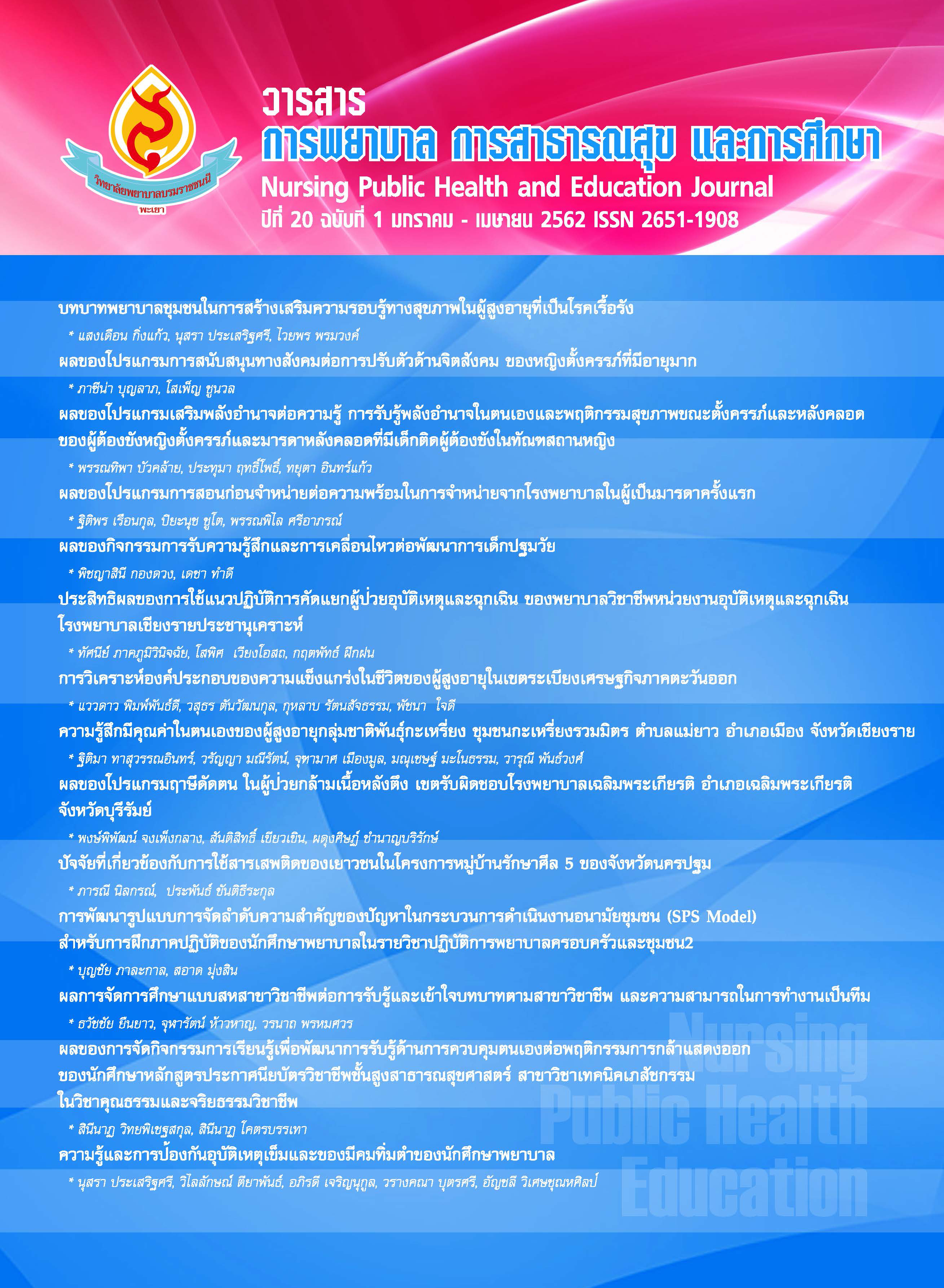ความรู้และการป้องกันอุบัติเหตุเข็มและของมีคมทิ่มตำของนักศึกษาพยาบาล
คำสำคัญ:
Needle sticks and sharps injury, Nursing Students, Knowledge and Prevention, อุบัติเหตุเข็มของมีคมทิ่มตำ, นักศึกษาพยาบาล, ความรู้การป้องกันบทคัดย่อ
นักศึกษาพยาบาลมีความเสี่ยงต่ออุบัติเหตุเข็มของมีคมทิ่มตำ ความรู้และการป้องกันอุบัติเหตุเข็มและของมีคมทิ่มตำมีความสำคัญเพื่อลดความเสี่ยงต่อการเกิดโรคที่ผ่านทางเลือดจากอุบัติเหตุเข็มและของมีคมทิ่มตำการวิจัยเชิงพรรณนาแบบภาคตัดขวางครั้งนี้มีวัตถุประสงค์เพื่อ 1) ศึกษาอุบัติการณ์ของอุบัติเหตุเข็มและของมีคมทิ่มตำในนักศึกษาพยาบาล และ 2) ศึกษาความรู้การป้องกันอุบัติเหตุเข็มและของมีคมทิ่มตำของนักศึกษาพยาบาล กลุ่มตัวอย่างเป็นนักศึกษาพยาบาลจำนวน 473 คน รวบรวมข้อมูลโดยใช้แบบสอบถามออนไลน์จำนวน 15 ข้อความตรงของเครื่องมือ(IOC : Index of item objective congruence) รายข้ออยู่ระหว่าง 0.66-1 ความเที่ยงของเครื่องมือค่าสัมประสิทธิ์แอลฟ่าของครอนบัค เท่ากับ 0.81ได้รับแบบสอบถามตอบกลับคืน 430 คน คิดเป็นร้อยละ 90.9ผลการศึกษาพบว่า กลุ่มตัวอย่างส่วนใหญ่เป็นเพศหญิง ร้อยละ 91.8 อายุเฉลี่ย 21.41 ปี (SD =2.09) ได้รับวัคซีน HBVร้อยละ 42.5อุบัติการณ์ของอุบัติเหตุเข็มและของมีคมทิ่มตำร้อยละ 39.5นักศึกษาชั้นปีที่ 2 มีอุบัติการณ์มากที่สุดคะแนนเฉลี่ยความรู้และการป้องกันอุบัติเหตุเข็มและของมีคมทิ่มตำอยู่ในระดับปานกลาง (Mean= 7.24, SD=1.59)จากคะแนนเต็ม10 คะแนนนักศึกษามีความรู้อุบัติเหตุเข็มและของมีคมทิ่มตำแต่การปฏิบัติในบางข้อยังปฏิบัติไม่ถูกต้อง เช่น การสวมปลอกเข็มฉีดยาหลังเจาะเลือดหรือฉีดยาลดความเสี่ยงต่ออุบัติเหตุเข็มและของมีคมทิ่มตำการปฏิบัติเพื่อลดความเสี่ยงต่อการติดเชื้อหลังจากเกิดอุบัติเหตุเข็มและของมีคมทิ่มทันทีดังนั้นควรมีการเตรียมความพร้อมให้กับนักศึกษาพยาบาลโดยการให้ความรู้และวิธีการป้องกันอุบัติเหตุเข็มและของมีคมทิ่มสำหรับการฝึกปฏิบัติทางคลินิกอย่าต่อเนื่องโดยการใช้ห้องจำลองหรือห้องปฏิบัติการทักษะก่อนที่จะดูแลผู้ป่วยที่เกิดขึ้นจริง
Knowledge and Prevention of Needlestick Sharp Injury in Nursing Students
Student nurses are at high risk of blood-borne pathogens transmitted via needlestick and sharps injury.Preventions of needlestick and sharps injury are important to decrease the diseases that transmit though blood regarding to those injury. The purposes of this cross-sectional descriptive study were to 1) study the incidence of needlestick and sharps injury in nursing student, and 2) study student nurses'knowledge and prevention about needlestick and sharps injury.The sample was 473 student nurses.The data were collected by using online survey that composed of 15 questions.The content validity of tool was test,Index of item objective congruence(IOC) each item between 0.6-1.0. Reliability of tool was tested with Cronbach's Alpha = 0.81.The total number of completed surveys was 430(response rate =90.9%). The results found that most of the students were female (n= 198; 71%). Their mean age was 21 years (SD =2.5).Of 42.5% nursing students acquired HBV vaccine. The incident of exposure to needlestick and sharps injury was 39.5%(n =171), most of that was the 2nd year nursing student. The mean score for the knowledge was 7.24 out of 10 (SD =1.59). Student nurses have a moderate understanding of issues regarding needlestick and sharps injury.However, some of the questions were not correct for instant recapneedle syringe after injecting and the practice to reduce the risk of infection after an accident.Nursing students should be continuing prepared the knowledge and preventions of needlestick and sharp injury by employing a simulation or laboratory skills before practice in clinical settings.Nursing colleges should recommend and implement policy to allow all students to receive HBV vaccines before practicingin clinical settings.
เอกสารอ้างอิง
คมบาดและการสัมผัสสารคัดหลั่งในนักศึกษาพยาบาลวิทยาลัยพยาบาลบรมราชชนนีพะเยา. Journal of Nursing and Education, 6(2), 124-136.
อะเคื้อ อุณหเลข กะ และสุชาดา เหลืองอาภาพงศ์. (2556). การป้องกันอุบัติเหตุจากเข็มและของมีคมของ
โรงพยาบาลในประเทศไทย. Nursing Journal, 40, 130-142.
Centers for Disease Control and Prevention. (2018). Bloodborne infectious diseases: HIV/ AIDS, hepatitis B, hepatitis C. Retrieved 6 April 2018, from National Institute for Occupational Safety and Health Respiratory Health Division https://www.cdc.gov/niosh/topics/bbp/default.html
Green, B., & Griffiths, E. C. (2013). Psychiatric consequences of needlestick injury. Occup Med (Lond), 63(3), 183-188. doi: 10.1093/occmed/kqt006kqt006 [pii]
Hambridge, K. (2011). Needlestick and sharps injuries in the nursing student population. Nursing Standard (through 2013), 25(27), 38.
Hambridge, K., Nichols, A., & Endacott, R. (2016). The impact of sharps injuries on student nurses: a systematic review. British Journal of Nursing, 25(19), 1064-1071.
Jae-Young, L., & Jeong Sook, P. (2017). Predictors associated with occurrence of needlestick injuries in clinical practicum among nursing students. Journal of Korean Academy of Fundamentals of Nursing, 24(1), 84-94.
Kongsuwan, W., Oearsakul, B., & Matchim, Y. (2011). Knowledge, attitude, and performance of the universal precautions by nursing students of the Faculty of Nursing, Prince of Songkla University (Vol. 22).
Strauss, K. (2012). Risk of needlestick injury from injecting needles. Nurs Times, 108(40), 12, 14, 16.
Suliman, M., Al Qadire, M., Alazzam, M., Aloush, S., Alsaraireh, A., & Alsaraireh, F. A. (2018). Students nurses' knowledge and prevalence of Needle Stick Injury in Jordan. Nurse education today, 60, 23-27.
Unver, V., Tastan, S., & Coskun, H. (2012). The frequency and causes of occupational injuries among nursing students in Turkey. Archives of environmental & occupational health, 67(2), 72-77.
van der Molen, H. F., Zwinderman, K. A., Sluiter, J. K., & Frings-Dresen, M. H. (2011). Better effect of the use of a needle safety device in combination with an interactive workshop to prevent needle stick injuries. safety Science, 49(8-9), 1180-1186.
Wicker, S., Stirn, A., Rabenau, H., von Gierke, L., Wutzler, S., & Stephan, C. (2014). Needlestick injuries: causes, preventability and psychological impact. Infection, 42(3), 549-552.
Wilburn, S. Q., & Eijkemans, G. (2013). Preventing needlestick injuries among healthcare workers: a WHO-ICN collaboration. International journal of occupational and environmental health, 10(4), 451-456.
Yang, Y.-H., Wu, M.-T., Ho, C.-K., Chuang, H.-Y., Chen, L., Yang, C.-Y., . . . Wu, T.-N. (2004). Needlestick/sharps injuries among vocational school nursing students in southern Taiwan. American journal of infection control, 32(8), 431-435.
Zhang, X., Gu, Y., Cui, M., Stallones, L., & Xiang, H. (2015). Needlestick and sharps injuries among nurses at a teaching hospital in China. Workplace health & safety, 63(5), 219-225.



